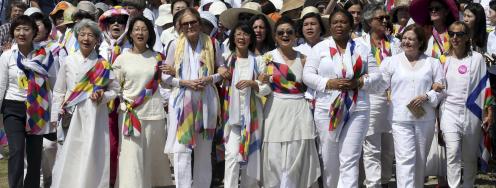Transition or Transfer in North Korea?
Asia watchers are pouring over recent announcements from North Korea and speculating about their meaning. While there is little doubt that things are afoot in Pyongyang, it is not exactly clear what.
The outside world in general and American observers in particular are extremely limited in their access to goings-on in the DPRK. So, reports of new ranks and titles for Kim Jong Il’s young son, Kim Jong Un, and other members of his family have stirred up a blizzard of predictions about succession. One word keeps coming up that it is important to challenge – transition.
Most articles refer to a “leadership transition” unfolding in the North. But we can’t know if we are witnessing a true transition – meaning a change in something – or if it is more accurate to assess this as a transfer of power. The distinction is subtle but significant. If the next few years see a relatively smooth and stable transfer of authority from Kim Jong Il to new leadership, with his son as the public face of it, and it is accepted internally, then we will have seen a transfer of power.
If, however, we are at the beginnings of a transition, that could be fraught with peril or hold great promise. Is the “son” potentially a reformer and will he consolidate enough authority to go the distance? Or will he seek to tighten an initially shaky grip by tried-and-true methods of authoritarianism and heavy-handedness? We just don’t know.
The upshot with either case, though, is this: our best strategy is to figure out entry points to engage with the North, especially during a potentially unstable period. Our current approach seems to be “well, let’s wait and see how the transition goes” and then figure out what to do. This passive approach risks too much; the chips that fall may be radioactive. Instead, the United States should be seeking some type of seat at the table, or even at the back of the room, to help ensure that any transfer is as stable as possible. Such engagement would also provide a better window on developments in Pyongyang. Any increase in knowledge about goings on there would be a marked enhancement to what we know now.
Entry points could take the form of clear signals from the United States and its allies that it will not take advantage of a period of vulnerability to weaken or destabilize the North. Or it could be more concrete gestures such as offers of humanitarian food and agricultural aid – always welcome by the North. When it comes to the North’s nuclear programs, the chief U.S. concern, there is a benefit in engaging now, while Kim Jong Il still retains authority. He, after all, still sets DPRK policy and can have it “stick.” We can’t be sure that new leadership will have the same credibility or authority in the near term, so why risk having even less of a toe hold?
Dealing with regimes as repugnant as North Korea is not easy from a moral standpoint, but in the long run if we want help the 23 million North Korean people improve their lives, and also improve the security situation in the region, we have to try. Why play the day-to-day parlor game of who gets what rank, when we can join the longer-term endgame of persistent, patient engagement with North Korea to slowly but surely bring it into the community of nations. That is the route to gain ground toward lasting security in the region, and ultimately the only way to eliminate its nuclear weapons.
Paul Carroll is the Program Director at Ploughshares Fund.



